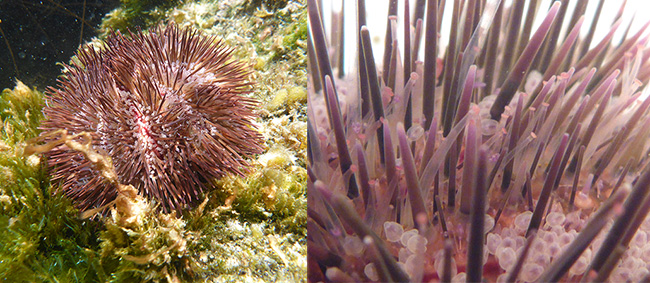
If you’ve ever been to the beach and walked around the rocks during low tide, you’ve probably seen a sea urchin. You may not have known that sea urchins found along the Pacific shore can live for more than 100 years. What’s even cooler is that, as they age, they don’t seem to lose their abilities to reproduce or regenerate damaged body parts. While different species of sea urchins have varying life expectancies, they all seem to share fountain-of-youth characteristics. For these and other reasons, scientists study sea urchins to investigate aging and other basic life processes.
One research team, led by Andrea Bodnar of the Bermuda Institute of Ocean Sciences and including James Coffman of the MDI Biological Laboratory, recently studied red, purple and variegated sea urchins to see if they show signs of aging. They investigated the ability of the sea urchins to regrow their spines (used for protection) and their tube feet (used for adhesion and sensory perception). They found that there was no real difference in the regenerative abilities of young and old sea urchins, regardless of whether they had short or long lifespans in the wild (variegated urchins live for about 4 years, purple urchins for about 50 years and red ones for over 100 years).
For the study, the researchers separated the sea urchins into two groups: old and young. They estimated the ages of the sea urchins by shell diameter and previously recorded growth curves. The urchins were collected around Bermuda, San Diego and British Columbia.
The researchers had thought the older specimens of the shorter-lived variegated sea urchins would have slowed regeneration and show more signs of aging, but they were surprised to see that was not the case. The thought had been that the animals with shorter natural lifespans would invest less energy into maintaining, repairing and defending their bodies.
The researchers plan to continue studying sea urchin longevity, particularly the role of the immune system in maintaining youthful function as the sea urchins age. What they learn could help scientists better understand the evolution of aging and possibly inform ways for improving our health into old age.
This work was supported in part by the NIH under grants through the IDeA program as well as grant R21AG039761.


It’s well established that; a dissociation exist between the rate of organ/tissue regeneration and the chronological age of a person within individuals. Which may be contributed by the degree of inflammation that we inherit at birth. The degree to which this process is inhibited or exacerbated may be influenced by the external environmental factors that each one is exposed to.
Hi there,
Firstly, A bunch of thanks for sharing such valuable information & research with us.
Actually, I was doing some research about Sea Urchin Regeneration & life processes. And I get landed over your article & it was too informative.
Thank you